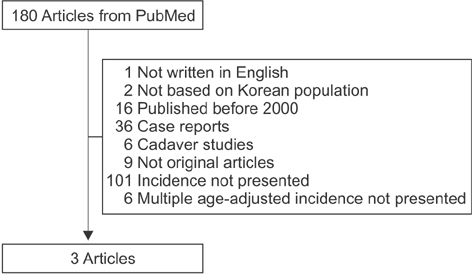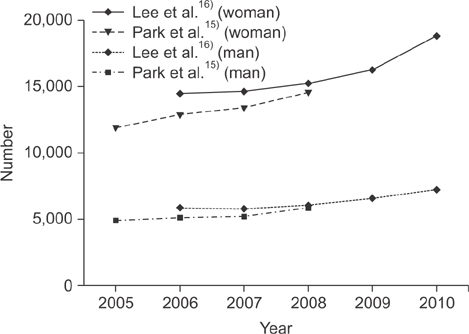Trend in the Age-Adjusted Incidence of Hip Fractures in South Korea: Systematic Review
- Affiliations
-
- 1Department of Orthopedic Surgery, Seoul National University Bundang Hospital, Seongnam, Korea. mkh1040@gmail.com
- KMID: 2412242
- DOI: http://doi.org/10.4055/cios.2017.9.4.420
Abstract
- BACKGROUND
The incidence of hip fractures has been reported to vary geographically, and its trend has also varied widely. However, the trend in the age-adjusted incidence of hip fractures has not been well studied in Korea. After we identified eligible studies presenting multiple age-adjusted incidences of hip fractures in the Korean population in PubMed, we evaluated changes in the absolute number of occurrence and calculated the annual percentage change (APC) of age-adjusted incidences of hip fractures.
METHODS
We have searched PubMed for the original and English-language literature on the incidence of hip fractures in the Korean population published since 2000. The studies presenting multiple age-adjusted incidences of hip fractures were selected. We evaluated the change in the absolute number of hip fractures and calculated the APC of age-adjusted incidences of hip fractures for each study.
RESULTS
Three eligible articles were identified. The absolute number of hip fractures for both genders increased over time in all three studies although the operational definition of hip fracture differed from one another. The APC of the age-adjusted incidence of hip fractures was positive for women and negative for men. However, the change was not statistically significant in both genders during each study period (2001-2004, 2005-2008, and 2006-2010, respectively).
CONCLUSIONS
The age-adjusted incidence of hip fractures was stable among men and women, while the absolute number of hip fractures increased for both genders in Korea. Further studies with longer study periods on age-adjusted incidences are required to better determine the trend in the incidence of hip fractures in Korea.
Keyword
MeSH Terms
Figure
Cited by 6 articles
-
Blood Transfusion for Elderly Patients with Hip Fracture: a Nationwide Cohort Study
Suk-Yong Jang, Yong-Han Cha, Jun-IL Yoo, Taeho Oh, Jung-Taek Kim, Chan Ho Park, Won-Sik Choy, Yong-Chan Ha, Kyung-Hoi Koo
J Korean Med Sci. 2020;35(37):e313. doi: 10.3346/jkms.2020.35.e313.Effect of Pneumonia on All-cause Mortality after Elderly Hip Fracture: a Korean Nationwide Cohort Study
Suk-Yong Jang, Yonghan Cha, Jun-Il Yoo, Young-Tak Yu, Jung-Taek Kim, Chan-Ho Park, Wonsik Choy
J Korean Med Sci. 2020;35(2):. doi: 10.3346/jkms.2020.35.e9.Incidence and Mortality of Osteoporotic Refractures in Korea according to Nationwide Claims Data
Jun-Il Yoo, Yong-Chan Ha, Ki Soo Park, Rock-Beum Kim, Sung-Hyo Seo, Kyung-Hoi Koo
Yonsei Med J. 2019;60(10):969-975. doi: 10.3349/ymj.2019.60.10.969.Outcomes of Combined Neck and Trochanter Fractures of the Femur Treated with Cephallomedullary Nail in Elderly
Hyunseung Yoo, Youngho Cho, Seongmun Hwang
Hip Pelvis. 2019;31(4):200-205. doi: 10.5371/hp.2019.31.4.200.Preoperative Iron Supplementation and Restrictive Transfusion Strategy in Hip Fracture Surgery
Byung-Ho Yoon, Beom Seok Lee, Heejae Won, Hyung-Kook Kim, Young-Kyun Lee, Kyung-Hoi Koo
Clin Orthop Surg. 2019;11(3):265-269. doi: 10.4055/cios.2019.11.3.265.Clinical Practice Guideline for Postoperative Rehabilitation in Older Patients With Hip Fractures
Kyunghoon Min, Jaewon Beom, Bo Ryun Kim, Sang Yoon Lee, Goo Joo Lee, Jung Hwan Lee, Seung Yeol Lee, Sun Jae Won, Sangwoo Ahn, Heui Je Bang, Yonghan Cha, Min Cheol Chang, Jung-Yeon Choi, Jong Geol Do, Kyung Hee Do, Jae-Young Han, Il-Young Jang, Youri Jin, Dong Hwan Kim, Du Hwan Kim, In Jong Kim, Myung Chul Kim, Won Kim, Yun Jung Lee, In Seok Lee, In-Sik Lee, JungSoo Lee, Chang-Hyung Lee, Seong Hoon Lim, Donghwi Park, Jung Hyun Park, Myungsook Park, Yongsoon Park, Ju Seok Ryu, Young Jin Song, Seoyon Yang, Hee Seung Yang, Ji Sung Yoo, Jun-il Yoo, Seung Don Yoo, Kyoung Hyo Choi, Jae-Young Lim
Ann Rehabil Med. 2021;45(3):225-259. doi: 10.5535/arm.21110.
Reference
-
1. Lee YK, Lee YJ, Ha YC, Koo KH. Five-year relative survival of patients with osteoporotic hip fracture. J Clin Endocrinol Metab. 2014; 99(1):97–100.
Article2. Kang BJ, Lee YK, Lee KW, Won SH, Ha YC, Koo KH. Mortality after hip fractures in nonagenarians. J Bone Metab. 2012; 19(2):83–86.
Article3. Nho JH, Lee YK, Kim YS, Ha YC, Suh YS, Koo KH. Mobility and one-year mortality of stroke patients after hipfracture surgery. J Orthop Sci. 2014; 19(5):756–761.
Article4. Yoon HK, Park C, Jang S, Jang S, Lee YK, Ha YC. Incidence and mortality following hip fracture in Korea. J Korean Med Sci. 2011; 26(8):1087–1092.
Article5. Kanis JA, Oden A, McCloskey EV, et al. A systematic review of hip fracture incidence and probability of fracture worldwide. Osteoporos Int. 2012; 23(9):2239–2256.
Article6. Cooper C, Campion G, Melton LJ 3rd. Hip fractures in the elderly: a world-wide projection. Osteoporos Int. 1992; 2(6):285–289.
Article7. Cooper C, Cole ZA, Holroyd CR, et al. Secular trends in the incidence of hip and other osteoporotic fractures. Osteoporos Int. 2011; 22(5):1277–1288.
Article8. Stevens JA, Rudd RA. The impact of decreasing U.S. hip fracture rates on future hip fracture estimates. Osteoporos Int. 2013; 24(10):2725–2728.9. Gullberg B, Johnell O, Kanis JA. World-wide projections for hip fracture. Osteoporos Int. 1997; 7(5):407–413.
Article10. Lau EM, Cooper C, Fung H, Lam D, Tsang KK. Hip fracture in Hong Kong over the last decade: a comparison with the UK. J Public Health Med. 1999; 21(3):249–250.
Article11. Koh LK, Saw SM, Lee JJ, Leong KH, Lee J. National Working Committee on Osteoporosis. Hip fracture incidence rates in Singapore 1991-1998. Osteoporos Int. 2001; 12(4):311–318.
Article12. Hagino H, Katagiri H, Okano T, Yamamoto K, Teshima R. Increasing incidence of hip fracture in Tottori Prefecture, Japan: trend from 1986 to 2001. Osteoporos Int. 2005; 16(12):1963–1968.
Article13. Hagino H, Furukawa K, Fujiwara S, et al. Recent trends in the incidence and lifetime risk of hip fracture in Tottori, Japan. Osteoporos Int. 2009; 20(4):543–548.
Article14. Lim S, Koo BK, Lee EJ, et al. Incidence of hip fractures in Korea. J Bone Miner Metab. 2008; 26(4):400–405.
Article15. Park C, Ha YC, Jang S, Jang S, Yoon HK, Lee YK. The incidence and residual lifetime risk of osteoporosis-related fractures in Korea. J Bone Miner Metab. 2011; 29(6):744–751.
Article16. Lee YK, Ha YC, Park C, Yoo JJ, Shin CS, Koo KH. Bisphosphonate use and increased incidence of subtrochanteric fracture in South Korea: results from the National Claim Registry. Osteoporos Int. 2013; 24(2):707–711.
Article17. Melton LJ 3rd, Kearns AE, Atkinson EJ, et al. Secular trends in hip fracture incidence and recurrence. Osteoporos Int. 2009; 20(5):687–694.
Article18. Wang Z, Bhattacharyya T. Trends in incidence of subtrochanteric fragility fractures and bisphosphonate use among the US elderly, 1996-2007. J Bone Miner Res. 2011; 26(3):553–560.
Article19. Korean Statistical Information Service [Internet]. Daejeon: Statistic Korea;cited 2017 Oct 15. Available from: http://www.kosis.kr.20. Ha YC, Park YG, Nam KW, Kim SR. Trend in hip fracture incidence and mortality in Korea: a prospective cohort study from 2002 to 2011. J Korean Med Sci. 2015; 30(4):483–488.
Article
- Full Text Links
- Actions
-
Cited
- CITED
-
- Close
- Share
- Similar articles
-
- Is the Incidence Rate of Hip Fractures still Increasing in Korea?: An Epidemiologic Study Based on National Health Insurance Database
- The incidence of hip fracture and mortality rate after hip fracture in Korea: A nationwide population-based cohort study
- Trend in Hip Fracture Incidence and Mortality in Korea: A Prospective Cohort Study from 2002 to 2011
- Recent Epidemiology of Hip Fractures in South Korea
- Incidence of Hip Fractures in Jeju Island, South Korea: A Prospective Study (2002-2006)



